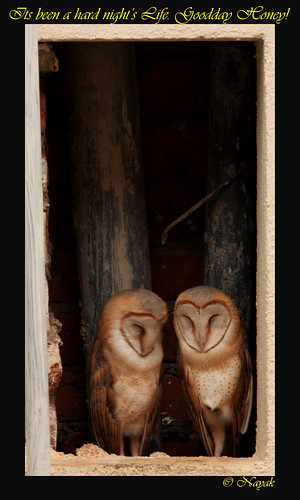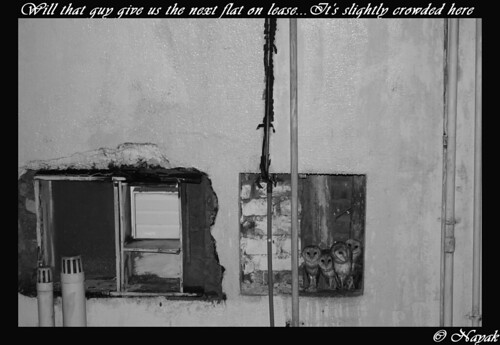It is against my policy to disturb nesting birds. So, I used to observe them by hiding behind the curtains. The pegions were also having some interesting times with the Owl family growing up.
I managed to get a few shots of the family when they were slightly grown-up and I felt it was okay to sneak up to take those shots.
Some of them, I post for all of you.
Goodmorning sunshine and mmuaaanh :-)

Ah!!!I am sleepy...

Its been a hard night's work and I have been working like an owl- Sorry Beatles ;-)

And this is how the pegions were amused...reminds me of living in flats...



And finally the family photo :-)

Hope u liked it as much I liked making it :-)
Some more details on Barn owls, just in case you are more interested, is as follows:
Scientists believe that the barn owl originated as a dweller in high clay cliffs of Europe and this may be one reason why the birds prefer the vertical walls of manmade structures even over trees. There may be other advantages in "owning" a barn, particularly in the winter. Long periods of heavy snow can result in high mortalities in barn owl populations since their prey is too far beneath the snow to catch. But a barn may provide an available supply of rodents during these periods, allowing the resident barn owls to survive.
Highly successful, the barn owl spread through all the known continents, and morphed into 35 subspecies, some of them confined to single island chains. The two best known races are the Barn Owl of Europe, Tyto alba alba, and the North American Barn Owl, Tyto alba pratincola.
PHYSICAL CHARACTERISTICS
Barn owls share a number of traits with other owls: large eyes, well-developed facial disks, soft feathering for silent flight, cervical bones that allow the head to turn 180 degrees, and four sharply clawed toes, one of which can be turned forward or backward.Barn owls are medium sized owls, standing approximately 10 to 12 inches high, and though they look like they weigh significantly more, they usually weigh about a pound (454 grams).Although female barn owls tend to have darker plumage and males tend to be whiter, this is only a generality and not a surefire way of determining sex.Although the barn owl can not see in total darkness, it can still fly very well in darkness so dim that a human could not navigate. They can hear so well that they can hunt with high accuracy in total darkness by homing in on the footsteps and nibbling sounds that rodents make. Some researchers believe that they can actually tell what type and size of rodent they are hearing.The reason that barn owls bob and weave their heads is to gain depth perceptionAlthough they are most noted for their high-pitched scream, barn owls produce a number of sounds: from the hen and young “snoring” in the nest to chirps, twitters, and tongue clicks—some used for bonding, begging for food, mating rituals, and danger warnings.BEHAVIOR
They tend to habitually perch in the same spot—usually in the same area they breed, and are known to remain quite still.When they do not perch inside buildings, they most often use thickly grown evergreens and, despite their pale plumage, are exceedingly difficult to spot.They tend to be less territorial than other raptors, and numerous instances of communal nesting have been recorded, one of the most notable when over 30 birds were found living in an abandoned steel mill in Utah. They most often hunt at dusk, midnight, and dawn, but in times of hunger may hunt in broad daylight.They will often kill more than they can eat and stockpile food for later.Barn owls produce about two pellets per day. These are the indigestible parts—the fur and bones of the animals they eat, compressed into an oblong shape in their cropIn some areas of the world, barn owls prey primarily on bats, birds, insects, and lizards, and have been seen successfully hauling fish from lakes and streams.
BREEDING AND DEVELOPMENT
Although they are strongly associated with nesting in barns, these owls also will use hollow trees, and in the western United States will nest in gullies and have even been known to hollow out a bank with their feet.Eggs are dull white and elliptical, and are usually laid at two to three days intervals. Clutch size is often large for a raptor—up to 13 eggs have been found in one nest, and 11 chicks in another. Three to seven is more common. Eggs take between 29 and 34 days to hatch.The eyes of the chicks remain closed for about 12 days.The young take approximately 8 weeks to fledge.Quills emerge at around 13 days.At 28 days, the tail feathers emerge and the iris turns from yellow to brown.By 35 days, the birds begin to wander around the nest; the eldest may peer out of the entrance hole.The young begin to wander from the nest between 5 and 8 weeks old, but generally can not fly well until their 8th week.Once fledged, young barn owls suffer a high mortality—studies have consistently shown between 60 and 80 percent perish in their first year. Fledglings in the northern United States tend to disperse wide and far before the winter—some birds travel over a thousand miles, and the predominant direction is south. In the spring, some birds show a tendency to return toward their natal area. Barn owls can reproduce in their first year. STATUS IN THE UNITED STATES
In North America, the barn owl inhabits almost every state. Prior to European settlement, barn owls were rare in the northern states, but as the forests were cleared for farmland, the barn owl became a common frequenter of barns and farmlands. Since the 1950's, barn owl populations have declined in many northern states. This is due to a variety of factors including the destruction of grasslands and wetlands, the replacement of wooden barns by metal barns, and the practice by modern farmers to do away with hedgerows and wild areas on their farms.Now, many states are attempting to bring back their grasslands and wetlands, and the barn owl may very well start recovering in these areas. The erection of nest boxes is an important part of barn owl conservation efforts.

This is really cool. Came across this post because there are barn owls in my building in Koramangala.
ReplyDelete